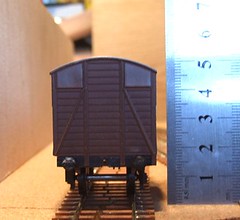 Last week I mentioned the building that was to inspire the left hand corner of my layout in a box. Finally I’ve actually started working on it.
Last week I mentioned the building that was to inspire the left hand corner of my layout in a box. Finally I’ve actually started working on it.The first step was to measure the required platform height. I know there are standards for this sort of thing but they all need to work from the top of the rail to allow for different sleeper thicknesses. Not wanting to be bothered with this, I did some original research and came up with 18mm as you can see from the photo. In theory this will allow the doors of the van to open without catching the slabs. Pedants pointing out that the doors are part of a moulded one-piece body can shut up, they could open. Wanting to be on the safe side I’ll be aiming the platform top another mm or so lower, not that you can really see as it’s behind the siding so any discrepancies will be covered.
With this critical dimension, I was able to draw up a rough building side to see what it looks like. The windows are from Dornaplas and plonked on to give me an idea of proportions. They work out surprisingly well resulting in 10 foot high floors which I think is about right for a warehouse. They tended to vary from 6 and a bit ft upwards (I once did a show in the canal warehouse in Coventry. The ceiling is slightly barrelled and I had to stand in the tall bits and stoop slightly when walking around. The facia and lifts didn’t get attached to the layout that time) to today’s cavernous tin sheds.
Sliding doors have been arranged to match the position of van doors when the siding is in use. Presumably the 4mm scale workforce want to be able to wheel goods out of the van straight into store. A little fiddling made sure that when they slide open, nothing hangs over the end of the platform.

No comments:
Post a Comment